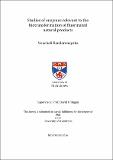Studies of enzymes relevant to the biotransformation of fluorinated natural products
Abstract
This thesis is focused on enzymes related to the biosynthetic pathway of fluorometabolite
synthesis in S.cattleya. The first native fluorinating enzyme, fluorinase was isolated from a
soil bacterium, Streptomyces cattleya in 2002. Fluorinase catalyses the reaction between
S-adenosyl-L-methionine and inorganic fluoride to produce 5′-fluoro-5-deoxyadenosine (5′FDA) and L-methionine as the first step of the fluorometabolite biosynthetic pathway.
Fluorinase has been an attractive tool for incorporating ¹⁸F into a limited number of
substrates for applications in positron emission tomography (PET). This thesis describes
a preparation of the fluorinase for PET, and then the production of [¹⁸F]-5-fluoro-5-deoxy-
D-ribose ([¹⁸F]-FDR) via fluorinase mediated enzymatic synthesis. S. cattleya fluorinase
has been the only fluorinase identified until recently when four more fluorinases have been
identified by gene mining. These new fluorinase isolations are presented in the thesis. In
addition this thesis describes the crystallisation of 5-deoxy-5-fluoro-D-ribose 1-phosphate
isomerase (FDRPi), an aldose-ketose isomerase involved in the biosynthetic pathway of
fluorometabolite biosynthesis in S.cattleya.
Chapter 1 presents the background of this research focusing on the enzymes involved in
the biosynthesis of the two fluorometabolites; fluoroacetate and 4-fluoro-L-threonine,
produced by S.cattleya.
Chapter 2 describes the development of a practical, ‘off the shelf’ method of producing
[¹⁸F]-FDR in remote radiochemistry labs. Enzymes, fluorinase and nucleoside hydrolase,
isolated from Trypanosoma vivax (TvNH) were freeze-dried in their buffers to produce a
shelf stable, potentially portable kit, where rehydration on site, would then provide catalysts
on demand for radiochemical synthesis of [¹⁸F]-FDR. This kit was practical enough to
conduct a successful tumour imaging using a mouse model at Vrije University in
Amsterdam.
Chapter 3 presents the over-expression and purification of fluorinase gene product (FLA1)
from a newly isolated soil bacterium Streptomyces sp. MA37. The gene was identified by
sequence mining of the Streptomyces sp. MA37 genome. This fluorinase shared high
homology to S.cattleya fluorinase and the flA1 was cloned into E.coli, over-expressed,
purified, assayed and shown to be a fluorinase. The FlA1 was also crystallized and the
structure solved.
Chapter 4 describes the successful crystallisation of FDRPi, an enzyme involved in the
fluorometabolite synthesis of S. cattleya. The FDRPi was over expressed, purified,
crystallised and the structure was solved.
Type
Thesis, PhD Doctor of Philosophy
Collections
Items in the St Andrews Research Repository are protected by copyright, with all rights reserved, unless otherwise indicated.

